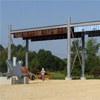Bowen Lab Projects - Bridges
Probability of Detection Study for Bridge Inspection Related to Steel Bridges
To evaluate the current performance of inspectors with the industry's present standards of training, a comprehensive Probability of Detection (POD) study is underway to determine the likelihood of inspectors finding cracks of various sizes and surface corrosion on a bridge structure. This study will test an inspector's ability to identify different defects under various environmental conditions on a bridge structure.
Member-level Redundancy in Built-up Steel Members
The objective of this research is to quantify the redundancy possessed by built-up steel members (bolted or riveted). Typically, built-up members will not 'fail' if one of the components fails (whether through fatigue or fracture). However, there is very little experimental data quantifying the remaining fatigue life and strength of a member in which one of the components has failed.
Modal Analysis and Load Identification Techniques for a Rapidly Emplaced Bridge System
This project's goals are first to determine through experimental procedures the vibration behavior of a military-type deployable bridge under various types of loading conditions, e. g.: moving mass, moving load and moving oscillator travelling along the bridge at different speeds; and second, to develop a valid approach to identify the type of load the bridge is subjected to from experimental data only.
Laboratory Testing of Railroad Flatcars For Use as Highway Bridges on Low-Volume Roads to Determine Ultimate Strength and Redundancy
Several counties in Indiana use retired railroad flatcars for a bridge superstructure to replace existing deteriorating county bridges. There are over 130 railroad flatcar bridges in the state of Indiana. The main objective of this laboratory project is to provide greater confidence to county engineers when load rating these bridges by studying the ultimate strength and load redundancy of the bridge system. Testing in the laboratory creates the opportunities to test at larger loads, use a greater number of instrumentation, and simulate a controlled fracture test.
Increasing Bridge Deck Service Life
The Indiana Department of Transportation is funding this project with an objective of developing a bridge deck that has a service life of 75-100 years. To potentially improve the durability and performance of bridge decks, new types of alternative materials are evaluated. The alternative materials considered in this research are four different types of solid stainless steel (316LN, Duplex 2205, Duplex 2304, XM-28), MMFX II microcomposite steel, dual coated steel with zinc and epoxy, zinc-clad steel, and hot-dip galvanized steel.
Efficient Load Rating and Quantification of Life-Cycle Damage of Indiana Bridges Due to Overweight Loads
The project aims at studying the relationships between, (i) overweight trucks, (ii) load rating and damage of bridges due to the overweight trucks, (iii) associated maintenance costs, and, (iv) the reduction is service-life due to damage.
Reliability Based Bridge Inspection
The objective of this project is to develop reliability based inspection practices to improve the safety and reliability of bridges and optimize resources for bridge inspection. The proposed methodology asks: What can go wrong? How likely is it? What are the consequences if it happens? Answers to these questions are then used to determine a bridge inspection interval based upon a reliability matrix. Historical data is being used to verify the methodology, and an implementation plan is being developed.
Performance Evaluation of Crack and Deck Sealants for Concrete Bridge Decks
Corrosion of steel reinforcement from salt intrusion can greatly reduce the service life of a concrete bridge deck. Sealants applied to the deck surface and within cracks can reduce this corrosion. Sealant product performance is tested with electrically wired macrocells that are exposed to saline solution for long-term intervals. Specimens are opened, visually inspected, and compared to evaluate performance.
NCHRP Project 10-72 - Bridge Deck Design Criteria and Testing Procedures
Although not often recognized for their significance by the motoring public, deck elements of highway bridges are important components for an efficient highway system. Robust performance of these components over the long-term is critical for smooth daily traffic operations as well as adequate bridge system performance during extreme events.
In-Service Inspection Frequency for Non-Load-Path Redundant Bridges
It is well recognized that the major impact on life-cycle costs is the additional mandate for hands-on in-service inspection of fracture-critical members. In fact for some owners, fracture-critical inspections consume a large fraction of the available inspection budget for a comparatively few structures. The cost of the fracture-critical inspection is typically 2 to 5 times greater than inspections for bridges without any FCMs.
Experimental Evaluation and Implementation of Post-Tensioning in Concrete Bridge Decks
An experimental evaluation of post-tensioning in concrete bridge decks is being carried out to verify design recommendations derived from analytical models for slab-on-girder bridges.
AASHTO Fracture Control Plan and Revisions to LRFD Fatigue Design Specifications
Primarily in response to failures during the late 1960's and 1970's, the material, design, fabrication, shop inspection, and in-service inspection requirements were improved for steel bridges in general. Special provisions for fracture critical members (FCM) were later implemented in 1978 mainly in reaction to bridge collapses.
Viewing 1 to 12 of 12












